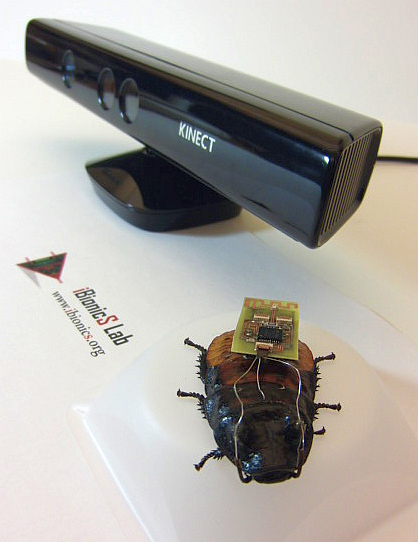Video Game Tech Steers Cyborg Cockroach

Scientists are harnessing the power of motion-based gaming technology to drive cyborg cockroaches on autopilot, envisioning a future where the intrepid insects could be wired to survey a disaster zone.
Researchers at North Carolina State University previously showed that they could steer roaches by remote control with a lightweight chip fixed to the critters. Now they're demonstrating that they can send the insects along a digitally plotted path with the help of Microsoft's Kinect, the motion-sensing system that allows people to play Xbox games without a controller.
More sophisticated roach reconnaissance could be life-saving in disaster areas that are too dangerous for humans to enter. The same technology that allows Kinect to scan a room could help roach rescuers map the inside of a collapsed building, the researchers say. Roaches could also be equipped with microphones to detect survivors, or even small speakers to allow two-way communication between remote rescue crews and people who are trapped. [See Video of Cockroaches on Autopilot]
"We want to build on this program, incorporating mapping and radio frequency techniques that will allow us to use a small group of cockroaches to explore and map disaster sites," Alper Bozkurt, an assistant professor of electrical and computer engineering at NC State, said in a statement. "The autopilot program would control the roaches, sending them on the most efficient routes to provide rescuers with a comprehensive view of the situation."
Bozkurt and his colleagues figured out how to manipulate Madagascar hissing cockroaches by wiring the creatures' antennae and cerci, the sensory organs on the insect's abdomen that cause it to scurry away from danger. Electrical signals that stimulate the cerci send the roaches running, while charges sent to the antennae control the insects' direction.
The team incorporated Kinect into their own electronic interface to automatically steer and track the movements of the insect along a charted path. A video of one of the cyborg roaches shows it lurching from point to point along a curved route.
Researchers elsewhere have been creating technologically enhanced roaches with other power sources. Scientists at Case Western Reserve University last year demonstrated how the insects could be outfitted with an implantable biofuel cell that converts sugar into electricity, used to power sensors on the insect or manipulate it remotely.
Sign up for the Live Science daily newsletter now
Get the world’s most fascinating discoveries delivered straight to your inbox.
Remote-controlled cockroaches are also making their way outside of university labs. For a donation of $100, a project on Kickstarter called RoboRoach promises the tools to create "the world's first commercially available cyborg" controlled by a smartphone.
The NC State team is presenting their work on July 4 at the annual conference of the IEEE Engineering in Medicine and Biology Society in Osaka, Japan.
Follow Megan Gannon on Twitter and Google+. Follow us @livescience, Facebook & Google+. Original article on LiveScience.com.











